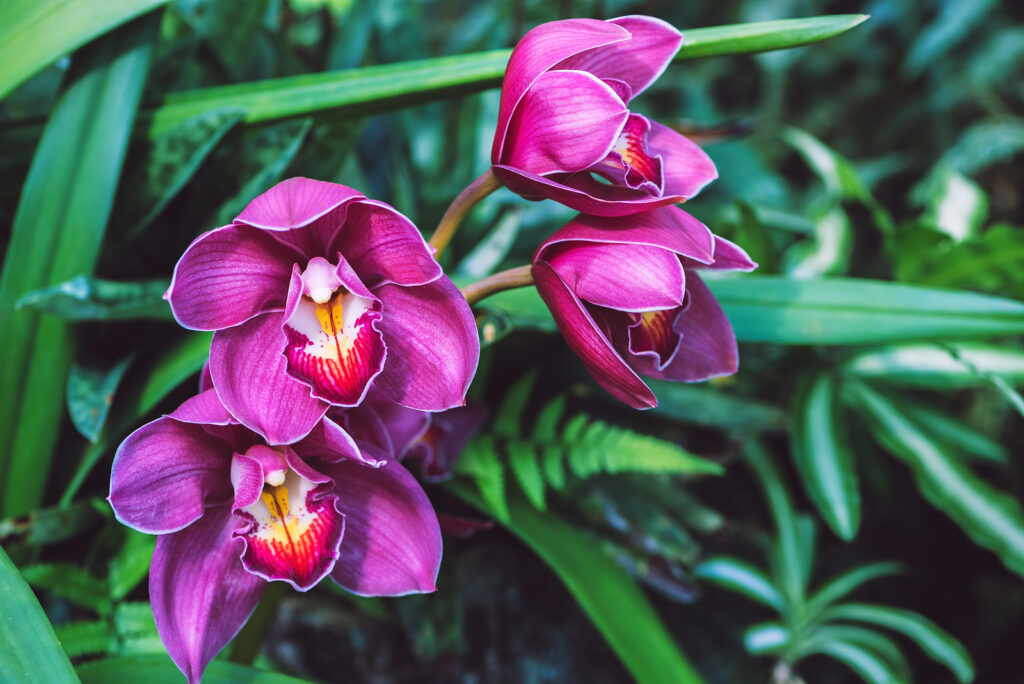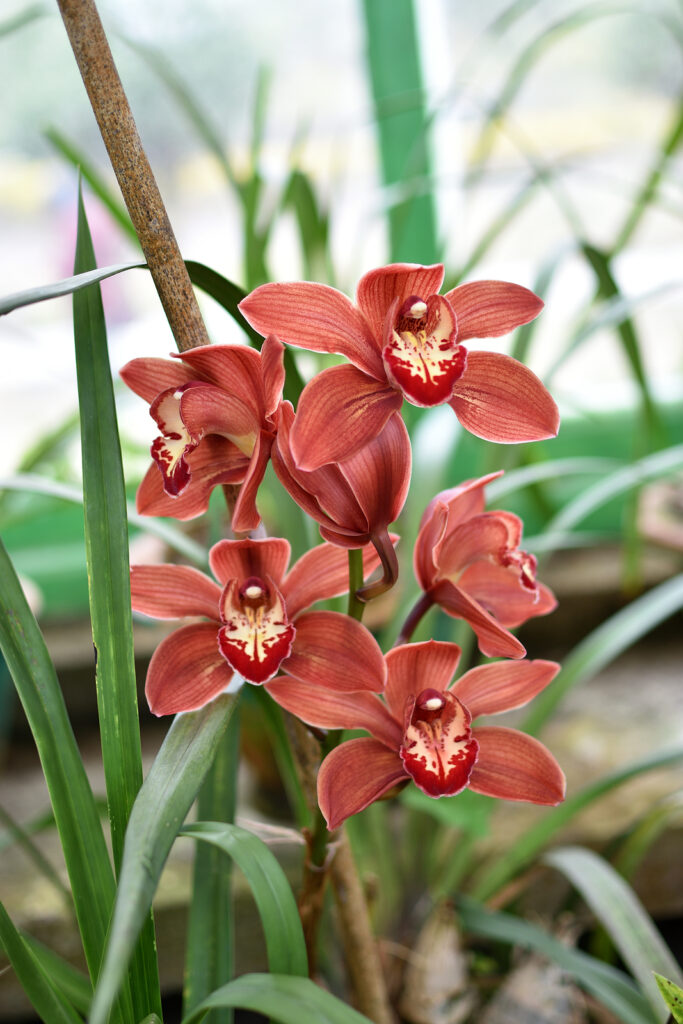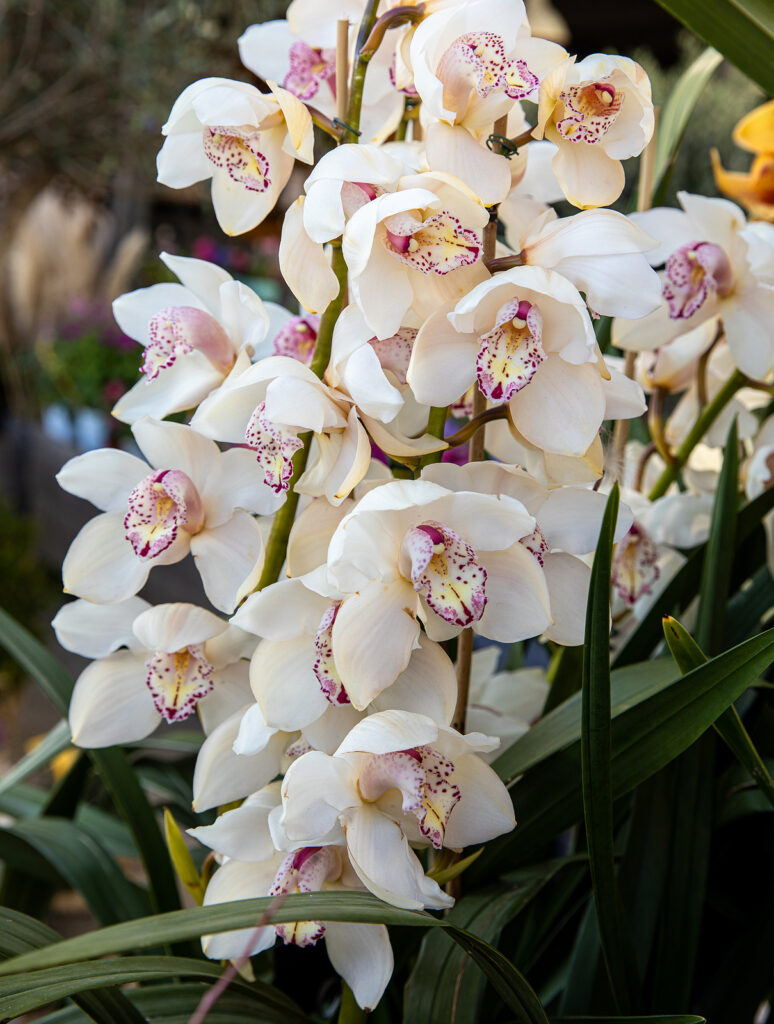Cymbidium are terrestrial orchids with long-lasting blooms. They are easy to grow and grow freely outdoors in frost-free regions. In cold-winter regions, Cymbidiums can be grown indoors or in a greenhouse and set outdoors in summer.
Cymbidiums are cool-growing orchids. There are hundreds of winter or spring-blooming Cymbidium hybrids.
Large Cymbidium species and hybrids have flowers that grow to 5 inches (12cm) across. There are many miniature hybrids with flowers half the size. Cymbidium flower colors include all but blue. Flowers last between 8 and 10 weeks.
Cymbidium is a genus of about 50 species. Cymbidiums are native to India, China, Japan, Southeast Asia, and Australia.

Get to know Cymbidium
- Plant type: Terrestrial orchid
- Growing zones and range: Zones 12-15; Cymbiums are cool-growing orchids
- Hardiness: Hardy to Zone 12; some larger species can tolerate short periods of 25°F (-4°C)
- Optimal growing temperature: day, 75° to 80°F (24 to 27°C); night, 45° to 50°F (7° to 10°C).
- Height and width: 12 to 36 inches (30-90cm) tall and wide depending on the variety.
- Foliage: Long, narrowly oval to linear, light to mid-green leaves
- Flowers: Five sepals and petals are similar and separate; labellum is significantly different from the other petals and the sepals and has three lobes; flowers in shades of cream, pink, and yellow;; miniature varieties are sweetly scented and can bear up to 30 flowers in a single season.
- Bloom time: Winter and spring flowering hybrids; blooms are long lasting even when cut, and remain attractive for 2 to 3 months on the plant.
- Uses: Houseplant or in a temperate greenhouse; grow in lath house in mild climates
- Common name: Cymbidium orchid
- Botanical name: Cymbidium
- Family name: Orchidaceae
- Origin: Temperate and tropical regions of India, China, Japan, southeast Asia, Australia
Where to plant Cymbidium
- Cymbidiums can be grown outdoors in mild-winter regions or in a lath house or greenhouse or indoors. Larger species can tolerate very cool temperatures.
- Light outoors: Plant Cymbidium where it will get bright light, but not hot direct summer sun. Cymbidium needs lots of light to flower but should be protected from the heat of intense summer sun.
- Because of light and temperature requirements, Cymbidium do especially well summered outdoors in the partial shade of large trees. They can be left outdoors until just before the first frost.
- Light indoors: Grow Cymbidium in bright light from northern, eastern exposure in summer, or full southern exposure in winter. Once buds begin to swell, gradually decrease amount of light to prevent bud drop; once flowering is finished, increase amount of light. Good circulation of fresh air is needed.
- Soil: Pot Cymbidium firmly in epiphytic or terrestrial orchid potting mix with added charcoal and bone meal. Cymbidium can be grown in Osmunda fiber or orchid bark mix. C. finlaysonianum should be grown in a hanging pot or in a slated basket.
When to plant Cymbidium
- Set Cymbidium outdoors any time of the year in tropical and subtropical regions.
Planting and spacing Cymbidium
- Space Cymbidium 12 to 36 inches (30-90cm) apart depending on the variety.

How to water and feed Cymbidium
- Water: Let growing medium dry slightly between thorough waterings. Mist frequently, never allowing direct sun to strike moistened leaves. Humidity, 40% to 50%.
- Feeding/Fertilize: For species plants, proportioned feedings of all-purpose fertilizer with each watering during active growth. Feed miniature hybrids only every 3 weeks during active growth to avoid burning leaf tips.
Cymbidium care
- As Cymbidium growth matures in late-summer and fall, many plants require 2 to 3 weeks of low nighttime temperatures (40° to 50°F/4° to 10°C) in order to initiate spikes.
- Cymbidium requires 2 periods of reduced watering; when new pseudobulb has matured and flower spikes are developing, and again when flowering is completed. Give only enough water to keep pseudobulb from shriveling. Rest period following flowering lasts 2 to 3 weeks; withhold fertilizer at this time.
Growing Cymbidium as a houseplant
- Indoors Cymbidium must have a cool to average temperature, high humidity, and bright light.
- Plant will not set flower buds unless the temperature is low (24° to 50°F) in fall.
- Use a growing medium made for orchids, and keep it evenly moist.
- Fertilize monthly using a complete fertilizer.
- Plants benefit from being moved outdoors in the summer and fall, or into a cool greenhouse when not in bloom.
Cymbidium pests and diseases
- Check Cymbidium for bacterial, fungal, and viral infections, mealybugs, scale, slugs, snails, spider mites, whiteflies, “Honey” on flower spikes may attract ants.
Cymbidium propagation
- Dividie Cymbidium in early and midspring when potbound.
- Remove backbulbs and put them up after flowering.

Cymbidium varieties to grow
- Cymbidium hybrids. There are hundreds of Cymbidium hybrids. Most hybrids found in garden centers are large-flowered varieties with white, pink, yellow, green, or bronze blooms. Many have yellow throats with dark red markings on the lip; large-flowered forms produce 12 or more 4 to 5 inch wide flowers per stem. Miniature varieties have flowers about half the size.
- C. finlaysonianum. Produces hanging spikes laden with many flowers; petals and sepals are narrow, colored deep red with yellow edging; burgundy-colored lip has creamy yellow stripe down the center; blooms in summer.
- C. lowianum. Grows to 36 inches (90cm) tall; bears 10 to 30 star-shaped flowers on an arching flowers spike; petals and sepals are yellow-green, diffused with brown; lip is creamy white with red margin; flowers appear in spring.















